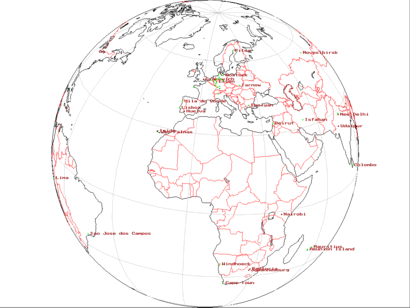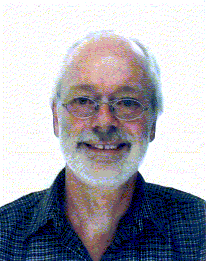 Essen, horizontal view
Essen, horizontal view
|
Internet Project
Observing, Photographing and Evaluating the
Transit of Venus, June 8th, 2004
|
 Essen, equatorial view
Essen, equatorial view
|
Venus has done it!
Project Results
Impressions from Essen
Instructions for the procedures of evaluating and publishing the results
are given on an additional page.
Another project site, together with German and Russian(!) translations of
this site, is due to
Städtisches Gymnasium Fürstenwalde.

(doesn't exist longer)
That site additionally contains a forum for discussion
among the participants of this project.
You can find the project
site and the forum by clicking the picture above.
You can download a  poster showing the
essentials of this project.
poster showing the
essentials of this project.
On June 8th, 2004 Venus will pass the Sun's disc - an event which looks
slightly different when observed from different locations on Earth.

| 
|
| Koblenz, 8.22 UT
| Windhoek, 8.22 UT
|
(by clicking on the above pictures you can see little related
animations)
The differences are smaller than the apparent radius of Venus and you can
recognize them only by exact measurements or by combinating simultaneously
taken pictures:

Therefore, an international cooperation between schools, amateur astronomers
and universities has prepared careful observations of the transit.
The main goals of the project are
- to form new contacts between schools, amateur astronomers and universities
and getting acquainted with internet collaboration,
- to gather information due to transits of Venus in the past, especially the
importance for determining the distance to the Sun, i.e. the Astronomical
Unit,
- to learn photographing the Sun and determining the exact direction to
north,
- to learn determining the exact position of an object (Venus!) on the Sun's
disc,
- to learn the mathematical methods of evaluating observations made from
different locations and,
- most important, to get our own measure for the distance of the Earth
to the Sun.
The basic ideas and intentions of this project a described in detail in a
paper which can, although not yet ready, be downloaded in an
English version and in a
German version.
Visibility of the Transit
| Daylight side of the Earth when Venus enters the Sun:
From this part of the world the 1rst and 2nd contact can be observed.
| Daylight side of the Earth when Venus leaves the Sun:
From this part of the world the 3rd and 4th contact can be observed.
|
| 5.20 UT | 11.30 UT
|

| 
|
The green dots mark the positions our paticipants whose
coordinates are known.
Preparation
The first problem for preparation can be found here!
The other Transit-of-Venus-Sites
we collaborated with, for instance
- the School Project Venus-Transit
 ,
,
- the Observational Project of Amateur Astronomers, Switzerland,
- the ESO Project and
- venus2004.org
don't exist longer.
Besides there are several other sites dealing with the transit of 2004 or,
respectively, with transits in general. We have collected those of the
most interesting of them and describe them shortly in a pdf-document. Looking at one of those sites you
will find a lot of additional information and links.
Some sources:
-
U. Uffrecht, Aufruf zu einem weltumspannenden Unterrichtsprojekt,
Astronomie und Raumfahrt 38/2, 18 (2001) (in German)
-
U. Uffrecht, Die Messung der Astronomischen Einheit, Sterne und
Weltraum 8/2001, 656 (in German)
-
S. Webb: Measuring the Universe, Springer: London etc. 1999, p. 44ff
-
Peter, B.: Untersuchung des Vorüberganges der Venus vor der
Sonnenscheibe im Jahre 1882, Nova Acta der Ksl. Leop.-Carol.-Deutschen
Akademie der Naturforscher, Band XXXIX. Nr. 5, Dresden 1877 (in German)
- Maor, E.: June 8, 2004 - Venus in Transit, Princeton University
Press: Princeton 2000
-
Newcomb, S.: Discussion of Observations of the Transits of Venus in 1761
and 1769, in: S. Newcomb, Astronomical Papers (prepared for the use of
the American Ephemeris ans Nautical Almanac) Vol. II, Washington 1891
-
R. Wolf: Handbuch der Astronomie ihrer Geschichte und
Litteratur,
Zürich 1890-1891, reprinted at Olms: Hildesheim 1973 (in German)
-
H. Woolf: The Transits of Venus, Princeton University Press:
Princeton 1959.
The participants of our project
have been pupils, teachers, amateur astronomers, university teachers and so on all
over the world.


 Prof. Dr. Udo Backhaus
Prof. Dr. Udo Backhaus
last modification: March 28th, 2008
 Essen, horizontal view
Essen, horizontal view
 Essen, equatorial view
Essen, equatorial view
 Essen, horizontal view
Essen, horizontal view
 Essen, equatorial view
Essen, equatorial view

 poster showing the
essentials of this project.
poster showing the
essentials of this project. ,
,


 Prof. Dr. Udo Backhaus
Prof. Dr. Udo Backhaus